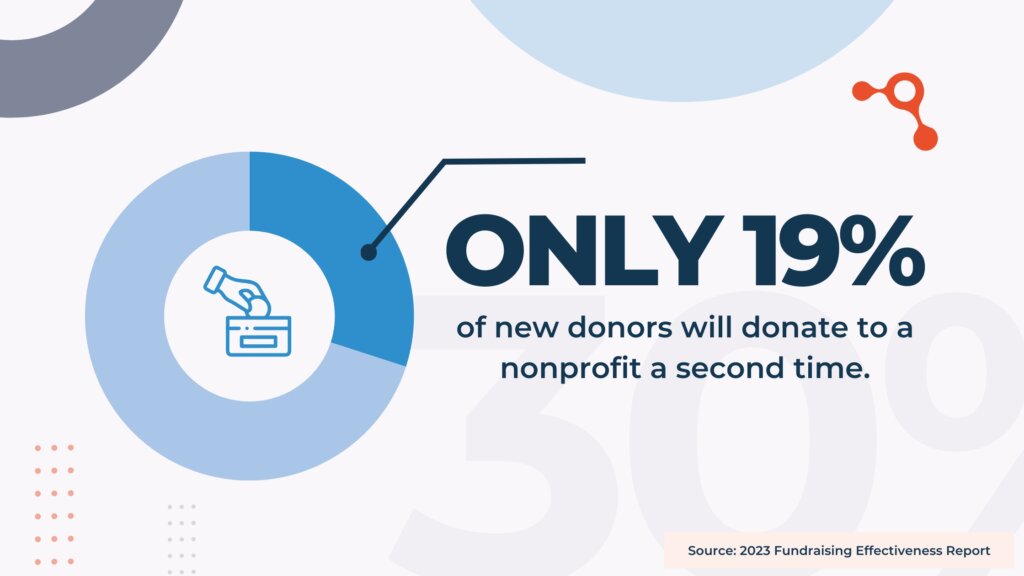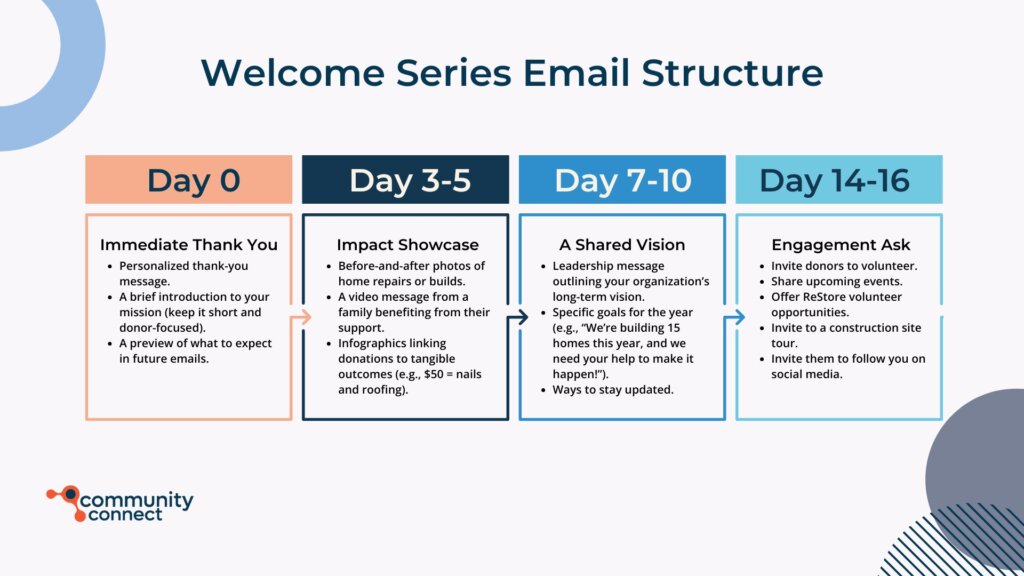How to Create an Effective New Donor Welcome Series
Regardless of what Habitat Collaborative Fundraising path you’ve selected, you likely have a lot of new donors from the recent holiday giving season. For many donors, this will be the first time they’ve interacted with you.
Now comes the most critical question: what happens next?
You’ve won their support—congratulations! But to keep these donors engaged, you need a plan. A donor welcome series is the perfect way to turn first-time givers into lifelong supporters, helping them see the difference their generosity makes while building a lasting relationship with your organization.
This guide will walk you through how to create an effective donor welcome series, including why it’s essential, how to structure it, and how to measure its success.
Why Your Nonprofit Needs a Donor Welcome Series
Here’s a reality check: only 19% of first-time donors give again, according to the 2023 Fundraising Effectiveness Report.
That means 8 out of 10 donors might walk away unless you engage with them. But there’s good news: according to the same report, nonprofits with structured welcome series have nearly double the retention rates, reaching up to 40%.

A welcome series isn’t just about sending emails. It’s about turning your donor’s initial gift into the start of a meaningful relationship. By focusing on connection, gratitude, and impact, you can inspire donors to stick around and contribute even more to your mission.
How to Structure Your Donor Welcome Series?
A welcome series isn’t a stage for your mission statement. It’s a chance to spotlight your donor as the hero. Share stories that show the impact of their support and make them feel appreciated.

Skip the jargon and focus on connection. Your donor didn’t give because of your mission statement—they gave because they care. Show them how their generosity is driving change.
copy& paste our welcome series email content
Don’t recreate the wheel. We already wrote the emails for you. Simply copy/paste/customize. You’re ready to go!
Here’s how an effective welcome series might look:
Email 1: The Immediate Thank You (Day 0)
Send your first email immediately after receiving a donation or donor information. This is your chance to say thank you and set the tone for the relationship.
What to include:
- A warm, personalized thank-you message.
- Quick confirmation of their donation amount (if you’re they donated directly to your affiliate).
- A brief introduction to your mission (keep it short and donor-focused).
- A preview of what to expect in future emails.
Example:
“Dear [Name], thank you for your generous gift of [amount]! Because of you, families in our community are gaining strength, stability, and self-reliance through affordable homeownership. I’m Sarah, your point of contact here at Habitat, and I’ll be sharing updates about how your gift is making an incredible difference.”
Email 2: Impact Showcase (Day 3-5)
Donors want to know their contribution matters. Use this email to showcase a story or example of how their gift is changing lives. Focus on storytelling and visuals.
What to include:
- Before-and-after photos of home repairs or builds.
- A video message from a family benefiting from their support.
- Infographics linking donations to tangible outcomes (e.g., $50 = nails and roofing).
Example Content Ideas:
“Meet the Johnson family, whose dream of homeownership became a reality thanks to donors like you. This week, they moved into a safe, affordable home where their children can thrive. Watch their journey in this short video.”
Email 3: A Shared Vision (Day 7-10)
Show donors they’re part of something bigger. This email highlights your nonprofit’s goals and inspires donors with a shared vision for the future.
What to include:
- A message from leadership outlining your organization’s long-term vision.
- Specific goals for the year (e.g., “We’re building 15 homes this year, and we need your help to make it happen!”).
- Ways to stay updated, such as following you on social media.
Email 4: Engagement Opportunities (Day 14-16)
Now’s the time to invite donors to get involved beyond their initial gift. This email should highlight different ways they can engage further with your nonprofit.
What to include:
- Invite donors to volunteer at a build site
- Share upcoming home dedications or other events
- Offer ReStore volunteer opportunities
- Promote team building opportunities for corporate donors
- Invite them to a construction site tour
- Invite them to follow you on social media
From First-Time to Lifelong Impact: Turning One-Time Donors into Monthly Supporters
Turning first-time donors into monthly supporters is one of the most impactful ways to grow your nonprofit’s sustainability.
Monthly giving provides a steady, predictable income stream that helps you plan and fund long-term projects. Plus, donors who give regularly feel deeply connected to your mission—they become partners in your cause.
To make the ask, timing is everything. I have seen some Habitat affiliates make this a part of their onboarding series. While others make it a regular campaign in the spring.
Either way to make this successful, consider the following:
- Build Trust First: Use your welcome series to thank donors and share impact stories. This lays the groundwork for a recurring giving request.
- Introduce Monthly Giving: Once you’ve established trust, send a dedicated email highlighting how small, recurring gifts can make a big difference over time.
- Make It Simple: Use a seamless sign-up process and show the tangible impact of monthly giving. For example, “$25 a month can supply materials for a new roof.”
How to Measure the Impact of Your Donor Welcome Series
It’s important to track how well your welcome series performs. Here are some key metrics to monitor:
- Open Rates: Are donors engaging with your emails?
- Click-Through Rates: Are they taking action, such as watching videos or clicking donation links?
- Retention Rates: How many first-time donors give again after the series?
Use this data to refine your content and timing for even better results.
Make Your Donor Welcome Series Multi-Channel for Greater Impact
While email is a cornerstone of any welcome series, relying on a single channel can limit your reach.
Donors engage with nonprofits in a variety of ways, so it’s crucial to meet them where they are—whether that’s their inbox, social media feed, or mailbox. A multi-channel onboarding strategy ensures your message resonates and builds stronger connections.
Here’s how to expand your donor welcome series across multiple channels:
- Social Media:
- Share donor appreciation posts on Facebook, Instagram, or LinkedIn. Highlight stories of impact and tag donors (with their permission).
- Post updates about current projects, inviting donors to follow along for progress updates.
- Direct Mail:
- Send a handwritten thank-you note or a personalized welcome letter. These gestures feel special and stand out from the digital clutter.
- Include a postcard featuring a success story or a QR code that links to a video about your work.
- Phone Calls:
- Consider making personal thank-you calls for larger donations. A quick, heartfelt conversation can deepen donor loyalty.
- Use this opportunity to answer questions and share ways to stay involved.
- Website Integration:
- Create a dedicated “Thank You” landing page for first-time donors with videos, testimonials, and ways to connect further.
- Use retargeting ads to remind visitors about opportunities to volunteer or become monthly donors.
- Text Messaging:
- Send a quick thank-you text with a link to a short video or photo update showcasing their impact.
- Keep it personal and concise, reserving texts for donors who’ve opted in.
By diversifying your welcome series, you increase the chances of connecting with donors on their preferred platforms. Just be sure to maintain a cohesive message and tone across all channels, reinforcing your gratitude and highlighting the difference donors make.
Making It Work with Limited Resources
As someone who’s managed communications for a Habitat affiliate, I know resources are tight. So, keep this process as simple as possible to get started.
Here are some things to consider to get started:
- Start simple with three emails and expand later
- Use templates to save time
- Repurpose existing content (build site photos, family stories)
Creating an effective donor welcome series doesn’t have to be complicated.
Focus on authenticity, impact, and building genuine connections with your donors. Remember, every email is an opportunity to show donors how they’re helping build stronger communities through affordable housing.
Final Thoughts: Build Connections That Last
A donor welcome series isn’t just a series of emails—it’s the start of a relationship. By making donors feel valued, sharing the impact of their generosity, and inviting them into your vision, you’ll create long-term supporters who are invested in your mission.
Ready to take the first step? Start small, track your progress, and keep refining. Your donors—and the communities you serve—will thank you.
